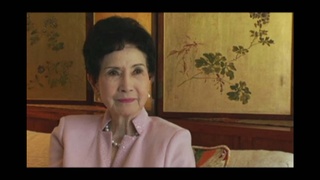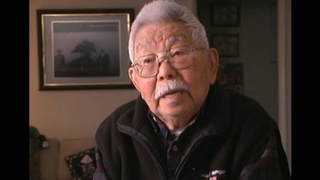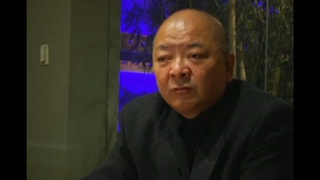Entrevistas
Paintings reflecting on camp
In a lot of ways it all came back to me again. Because not only was it just about making a documentary but the paintings were very emotional. They really depicted...and I really saw things visually now. I saw how...where the main painting, or the main title of the painting, which is used with the logo now, is, is a boy of me looking out among the wall of fences and sort of gate thing. Fence. And looking beyond Castle Rock at the sunset. 'Cause I always remember the sunset. At Tule Lake, they were just magnificent, you know. And, uh, you just never see anything like it. You know, even the other day, yester... when I was out there I saw the sunset and the it was just so beautiful. And just this boy's just looking out and it's wonderful as I said, and on the other half a painting, was a reverse. I'm looking out with these barracks in the background with a dark black gray barracks with the watchtower in the distance. Watchtowers you know and the fence. I mean not a fence but just like, the light..the way the fence was in the foreground in front of them, you know. And that was uh... that painting was the first painting that was sold. It just.. they saw this, this kid. Who was me. You, you know in this thing. You know I did one of the train and the one of the seagulls and the one in the train when my father was ill and I was sitting in the seat. And in the back he was in bed with my mother who was watching him, looking at him. And I remember just about every one of them. I did the snake. Well these were all watercolors. I did these in watercolors that was sold...
And I did one when we were in the camp and awaiting the cue, a line rather, you know, to...for breakfast, you know. I mean I drew all, all four of us, I think my sister, my dad, and that's why they did us, you know...And the, uh, the chef they would, you know how they would do their eggs, you know 'cause they have to feed seventy five people...how many people in one block that they, they'd get boxes of dozens of eggs throw it into this vat. The whole thing, shell and all. You know and you get this p-p- this fork and just crush all the egg shells and mix it around - scramble it - shell and all. You know. And then come with a screen and then come pick them up. Take the shells out, you know. But geez that screen was not taking all the shells out. It left the small ones. And as you were eating you'd always...I remember always as a kid I'd take the shells out. But, but without complaining because this is normal. This is the way you eat eggs, I thought. Take the shells off.
Data: June 29, 2012
Localização Geográfica: California, US
Entrevistado: Chris Komai, John Esaki
País: Watase Media Arts Center, Japanese American National Museum
Explore More Videos

Memórias dos jantares em família (Inglês)
(1925 - 2018) Professora nisei do Havaí

Bonsai e Pintura a Óleo (Inglês)
(1914-2004) Nisei mestre de Bonsai nos Estados Unidos

O sofrimento durante a Segunda Guerra Mundial (Espanhol)
(n. 1929) Nisei Argentino

Apreciação da comida japonesa (Inglês)
Nipo-americano sansei e praticante de Kendo residente no Japão

Resistindo à transferência de Jerome (Inglês)
(1919 - 2006) Veterano da Segunda Guerra Mundial e da Guerra da Coréia

Uma visita ao Jerome após OCS (Inglês)
(1919 - 2006) Veterano da Segunda Guerra Mundial e da Guerra da Coréia

Peru Representative vs. Japan Representative (Japanese)
(n. 1962) Dono e chef de restaurante japonês em Peru

World-Renowned Peruvian Cuisine (Japanese)
(n. 1962) Dono e chef de restaurante japonês em Peru

Fusion Cuisine (Japanese)
(n. 1962) Dono e chef de restaurante japonês em Peru

The Road to Success As a Sushi Chef (Japanese)
(n. 1962) Chef especialista em sushi

Going to camp with the Terminal Island people
(1927-2010) Ativista político


Interned at age fifteen, I saw camp as an adventure
(1927-2010) Ativista político

Recordações de Poston (Inglês)
(n. 1930) Medio japonesa y creció en Japón y los Estados Unidos.

Chegada em Poston (Inglês)
(n. 1930) Medio japonesa y creció en Japón y los Estados Unidos.
